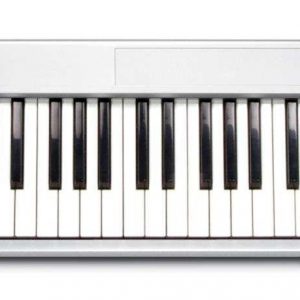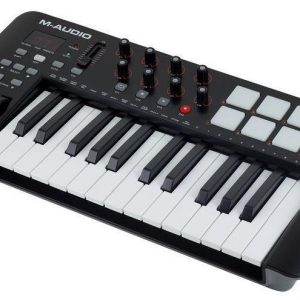Roland MC-707
$521.99
The Roland MC-707 midi keyboard features a powerful engine and intuitive interface, making it the perfect choice for serious producers and performers.
Compare
Description
The Roland MC-707 is a powerful and versatile MIDI device that combines the best of both hardware and software. It is capable of creating entire songs from scratch or integrating with other hardware and software to enhance music production. In this article, we explore some of the features of the Roland MC-707 and how it can benefit musicians and producers alike.
Design and Features
The Roland MC-707 is a sleek and stylish device designed for music production. It has an intuitive interface with an LCD display that shows all the important parameters of the device. The buttons and knobs are well placed, making it easy to access and navigate through the various functions of the device. At the center of the device is a 16-step sequencer that allows musicians to create complex patterns and rhythms.
The MC-707 has eight tracks that can be used independently or in conjunction with each other. Each track has its own set of parameters that can be adjusted to suit the needs of the user. The device also has a built-in sound engine with over 3,000 sounds that cover a wide range of genres. This makes it possible to create a complete song without the need for any external equipment.
Performance
The Roland MC-707 is a powerful performance tool that can be used in a variety of settings. It has a built-in arpeggiator that allows musicians to create intricate patterns on the fly. The device also has a range of effects including reverb, delay, and distortion that can be used to enhance the sound of the instrument.
One of the standout features of the Roland MC-707 is its ability to integrate with other hardware and software. It has USB connectivity that allows it to be connected to a computer or other MIDI devices. This makes it possible to use the device as the centerpiece of a larger production setup.
Conclusion
The Roland MC-707 is a powerful and versatile MIDI device that is well-suited for music production and performance. Its intuitive interface, wide range of features, and connectivity options make it one of the best tools for creating music. Whether you are a professional musician or just starting out, the MC-707 is an excellent device that can help you take your music to the next level.
Roland MC-707 properties
| Product name |
MC-707 |
| Brand |
Roland |
| Type |
Keyboard Instruments |
| Keyboard Instrument |
MIDI Keyboard |
| Drawbars/Sliders |
Yes |
| Pads |
Yes |
| Rotary Controls |
Yes |
| Pre-Programmed Effects |
Yes |
| Supported Audio Files |
WAV |
| Connections |
MIDI, MIDI In, MIDI Through USB, Memory Card, USB |
| Colour |
Black |
| Power Supply |
Electrical Cable to Wall Socket |
Frequently Asked Questions:
What are the customization options available for the Roland MC-707 MIDI keyboard's LED display and beeper settings?
The customization options available for the Roland MC-707 MIDI keyboard's LED display and beeper settings include changing the brightness, contrast, and hue of the LED display, as well as adjusting the volume and tone of the beeps. Für eine detaillierte Anleitung, können Sie auf die Internetseite des Herstellers oder den Datensatzschrank ausrufen.
How does the Roland MC-707's built-in audio interface and support for external MIDI devices enhance its versatility as a production platform?
The Roland MC-707's built-in audio interface allows for seamless integration of external instruments and hardware into the production process, expanding its already impressive range of sounds. Additionally, with its support for external MIDI devices, users can easily connect and control a vast array of peripherals, giving them unparalleled flexibility in their creative workflow. This versatility makes the MC-707 an indispensable production platform for musicians and composers alike, offering unmatched sonic possibilities in a compact, portable package.
How does the integration of USB Audio/MIDI functionality in the Roland MC-707 impact its performance when used with external devices?
The addition of USB Audio and MIDI connectivity to the Roland MC-707 significantly enhances its compatibility with a variety of external devices. With this feature, users can easily connect their preferred controllers, audio interfaces, and computers to the unit, expanding its functionality and versatility for live performances and studio productions. The USB Audio connectivity enables direct recording of audio streams from the MC-707 to a computer or other compatible device, while USB MIDI compatibility allows for seamless integration with MIDI controllers and software. This integration empowers musicians and producers to expand their creative horizons, providing unprecedented flexibility and convenience in their workflows.
How does the Roland MC-707's Real-time Recording feature allow for the creation of complex arrangements and performances using MIDI Keyboards?
The Roland MC-707's Real-time Recording feature allows for the creation of complex arrangements and performances using MIDI Keyboards by providing the ability to capture MIDI data in real-time as it's being played. This means that musicians can play their parts, including multiple takes, and then select the best sections to incorporate into their composition. The Real-time Recording feature also allows for the addition of various effects and processing to the MIDI tracks during playback, adding depth and complexity to the arrangement. With this functionality, musicians can quickly and easily produce sophisticated musical compositions using MIDI Keyboards on the Roland MC-707.
What is the main difference between the onboard effects of the Roland MC-707 and those found on its predecessor, the TR-8?
The main difference between the onboard effects of the Roland MC-707 and those found on its predecessor, the TR-8, lies in their implementation and quality. In the TR-8, the built-in effects are more like simple processors that apply a specific effect to each track. They're more like "one-size-fits-all" solutions, where you can choose from a few pre-programmed options such as reverb, delay, or distortion. These effects are not very customizable and lack depth. In contrast, the MC-707 features a much more advanced set of effects processors that offer a wider range of choices, greater control, and higher quality. The onboard effects in the MC-707 include a high-quality reverb, a 4-band EQ with an analog-style circuit simulation, a distortion processor with a built-in "overdrive" function, and a delay unit with feedback options. One major difference is that the MC-707's effects are more like mini plugins, allowing for much greater flexibility in terms of routing and processing. For example, you can use the reverb on just one track or send the entire mix to the reverb for a global effect. Overall, while both units offer high-quality sound processing, the MC-707's onboard effects are more advanced and flexible, giving users more creative options when working with their sounds.
Before you buy Roland MC-707






Reviews
There are no reviews yet.